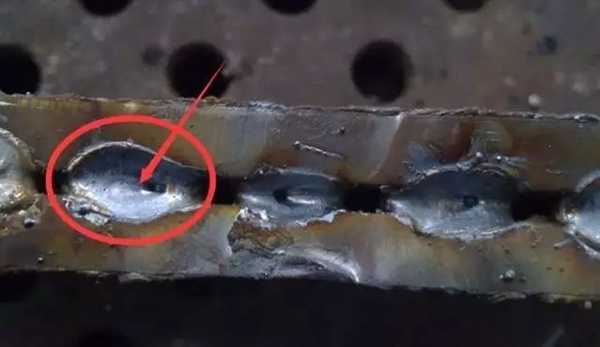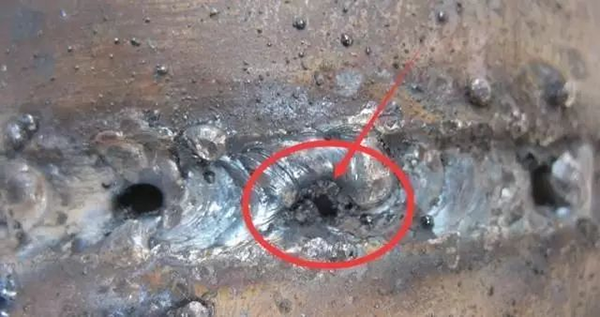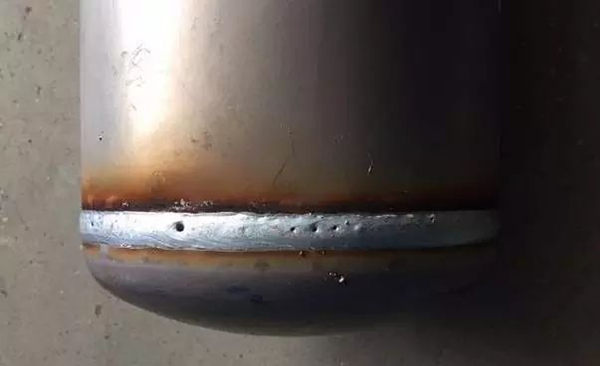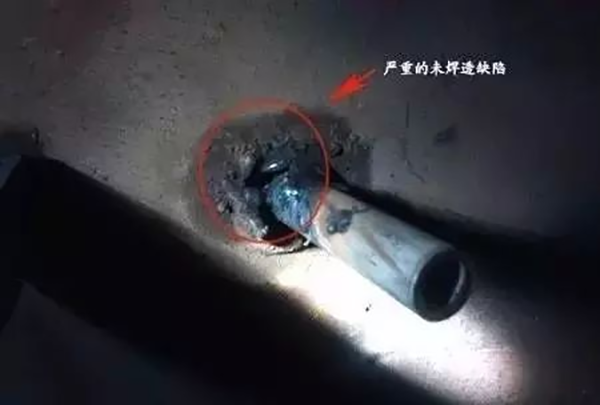Xinfa welding equipment has the characteristics of high quality and low price. For details, please visit: Welding & Cutting Manufacturers - China Welding & Cutting Factory & Suppliers (xinfatools.com)
4. Arc pits
It is a downward sliding phenomenon at the end of the weld, which not only weakens the weld strength, but also causes cracks during the cooling process.

4.1 Causes:
Mainly, the arc extinguishing time is too short at the end of welding, or the current used when welding thin plates is too large.
4.2 Preventive measures:
When the weld is finished, make the electrode stay for a short time or make several circular movements. Do not stop the arc suddenly so that there is enough metal to fill the molten pool. Ensure appropriate current during welding. The main components can be equipped with arc-starting plates to lead the arc pit out of the weldment.
5. Slag inclusion
5.1 Phenomenon: Non-metallic inclusions such as oxides, nitrides, sulfides, phosphides, etc. are found in the weld through non-destructive testing, forming a variety of irregular shapes, and common ones are cone-shaped, needle-shaped and other slag inclusions. Slag inclusions in metal welds will reduce the plasticity and toughness of metal structures, and will also increase stress, resulting in cold and hot brittleness, which is easy to crack and damage components.

5.2 Reasons:
5.2.1 The weld base metal is not cleaned properly, the welding current is too small, the molten metal solidifies too quickly, and the slag does not have time to float out.
5.2.2 The chemical composition of the welding base metal and the welding rod is impure. If there are multiple components such as oxygen, nitrogen, sulfur, phosphorus, silicon, etc. in the molten pool during welding, non-metallic slag inclusions are easily formed.
5.2.3 The welder is not skilled in operation and the rod transportation method is improper, so that the slag and molten iron are mixed and inseparable, which hinders the slag from floating.
5.2.4 The weld groove angle is small, the welding rod coating falls off in pieces and is not melted by the arc; during multi-layer welding, the slag is not cleaned properly, and the slag is not removed in time during operation, which are all causes of slag inclusion.
5.3 Prevention and control measures
5.3.1 Use welding rods with only good welding process performance, and the welded steel must meet the requirements of the design documents.
5.3.2 Select reasonable welding process parameters through welding process assessment. Pay attention to the cleaning of the welding groove and edge range. The welding rod groove should not be too small. For multi-layer welds, the welding slag of each layer of welds must be carefully removed.
5.3.3 When using acidic electrodes, the slag must be behind the molten pool; when using alkaline electrodes to weld vertical angle seams, in addition to correctly selecting the welding current, short arc welding must be used. At the same time, the electrode should be moved correctly to make the electrode swing appropriately so that the slag floats to the surface.
5.3.4 Use preheating before welding, heating during welding, and insulation after welding to make it cool slowly to reduce slag inclusions.
6. Porosity
6.1 Phenomenon: The gas absorbed in the melted weld metal during the welding process has no time to be discharged from the molten pool before cooling, and remains inside the weld to form holes. According to the location of the pores, they can be divided into internal and external pores; according to the distribution and shape of the pore defects, the presence of pores in the weld will reduce the strength of the weld, and also produce stress concentration, increase low-temperature brittleness, thermal cracking tendency, etc.

6.2 Reasons
6.2.1 The quality of the welding rod itself is poor, the welding rod is damp and not dried according to the specified requirements; the welding rod coating is deteriorated or peeled off; the welding core is rusted, etc.
6.2.2 There is residual gas in the smelting of the parent material; the welding rod and the weldment are stained with impurities such as rust and oil, and during the welding process, gas is generated due to high temperature gasification.
6.2.3 The welder is not skilled in operation technology, or has poor eyesight and cannot distinguish between molten iron and coating, so that the gas in the coating is mixed with the metal solution. The welding current is too large, making the welding rod red and reducing the protection effect; the arc length is too long; the power supply voltage fluctuates too much, causing the arc to burn unstablely, etc.
6.3 Prevention and control measures
6.3.1 Select qualified welding rods, and do not use welding rods with cracked, peeled, deteriorated, eccentric or severely rusted coatings. Clean the oil stains and rust spots near the weld and on the surface of the welding rod.
6.3.2 Choose the appropriate current and control the welding speed. Preheat the workpiece before welding. When welding is finished or paused, the arc should be slowly withdrawn, which is conducive to slowing down the cooling speed of the molten pool and the discharge of gas in the molten pool, avoiding the occurrence of pore defects.
6.3.3 Reduce the humidity of the welding operation site and increase the temperature of the operating environment. When welding outdoors, if the wind speed reaches 8m/s, rain, dew, snow, etc., effective measures such as windbreaks and canopies should be taken before welding operations.
7. Failure to clean spatter and welding slag after welding
7.1 Phenomenon: This is the most common common problem, which is not only unsightly but also very harmful. Fusible spatter will increase the hardened structure of the material surface, and it is easy to produce defects such as hardening and local corrosion.
7.2 Reasons
7.2.1 The medicine skin of the welding material is damp and deteriorated during storage, or the selected welding rod does not match the parent material.
7.2.2 The selection of welding equipment does not meet the requirements, the AC and DC welding equipment do not match the welding materials, the polarity connection method of the welding secondary line is incorrect, the welding current is large, the weld groove edge is contaminated by debris and oil stains, and the welding environment does not meet the welding requirements.
7.2.3 The operator is not skilled and does not operate and protect according to the regulations.
7.3 Prevention and control measures
7.3.1 Select appropriate welding equipment according to the welding parent material.
7.3.2 The welding rod must have a drying and constant temperature equipment, and there must be a dehumidifier and air conditioner in the drying room, which is not less than 300mm from the ground and the wall. Establish a system for receiving, sending, using, and keeping welding rods (especially for pressure vessels).
7.3.3 Clean the edge of the weld to remove moisture, oil stains, and rust from debris. During the winter rainy season, a protective shed is built to ensure the welding environment.
7.3.4 Before welding non-ferrous metals and stainless steel, protective coatings can be applied to the parent materials on both sides of the weld for protection. You can also choose welding rods, thin-coated welding rods and argon protection to eliminate spatter and reduce slag.
7.3.5 Welding operation requires timely cleaning of welding slag and protection.
8. Arc scar
8.1 Phenomenon: Due to careless operation, the welding rod or welding handle contacts the weldment, or the ground wire contacts the workpiece poorly, causing an arc for a short time, leaving an arc scar on the workpiece surface.
8.2 Reason: The electric welding operator is careless and does not take protective measures and maintain the tools.
8.3 Preventive measures: Welders should regularly check the insulation of the welding handle wire and ground wire used, and wrap them in time if they are damaged. The ground wire should be installed firmly and reliably. Do not start an arc outside the weld when welding. The welding clamp should be placed in isolation from the parent material or hung appropriately. Cut off the power supply in time when not welding. If arc scratches are found, they must be polished with an electric grinding wheel in time. Because on workpieces with corrosion resistance requirements such as stainless steel, arc scars will become the starting point of corrosion and reduce the performance of the material.
9. Weld scars
9.1 Phenomenon: Failure to clean weld scars after welding will affect the macroscopic quality of the equipment, and improper handling will also cause surface cracks.
9.2 Cause: During the production and installation of non-standard equipment, the positioning welding fixtures are caused when they are removed after completion.
9.3 Preventive measures: The hoisting fixtures used in the assembly process should be polished with a grinding wheel to be flush with the parent material after removal. Do not use a sledgehammer to knock off the fixtures to avoid damaging the parent material. Arc pits and scratches that are too deep during electric welding should be repaired and polished with a grinding wheel to be flush with the parent material. As long as you pay attention during operation, this defect can be eliminated.
10. Incomplete penetration
10.1 Phenomenon: During welding, the root of the weld is not completely fused with the parent material or the parent material and the parent material are partially incompletely welded. This defect is called incomplete penetration or incomplete fusion. It reduces the mechanical properties of the joint and will cause stress concentration and cracks in this area. In welding, any weld is not allowed to have incomplete penetration.

10.2 Causes
10.2.1 The groove is not processed according to the regulations, the thickness of the blunt edge is too large, and the angle of the groove or the gap of the assembly is too small.
10.2.2 When double-sided welding, the back root is not thoroughly cleaned or the sides of the groove and the interlayer weld are not cleaned, so that oxides, slag, etc. hinder the full fusion between the metals.
10.2.3 The welder is not skilled in operation. For example, when the welding current is too large, the base material has not melted, but the welding rod has melted, so that the base material and the welding rod deposited metal are not fused together; when the current is too small; the speed of the welding rod is too fast, the base material and the welding rod deposited metal cannot be well fused; in the operation, the angle of the welding rod is incorrect, the melting is biased to one side, or the phenomenon of blowing during welding will occur, which will cause incomplete penetration where the arc cannot act.
10.3 Preventive measures
10.3.1 Process and assemble the gap according to the groove size specified in the design drawing or specification standard.
Post time: Jul-28-2024



